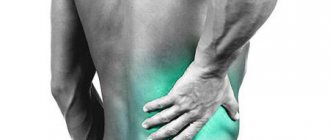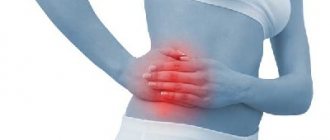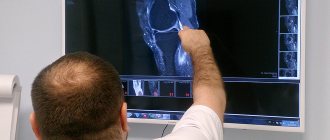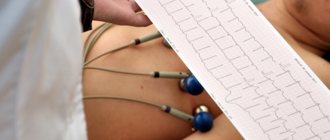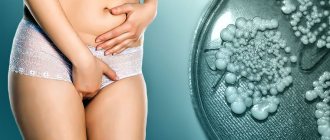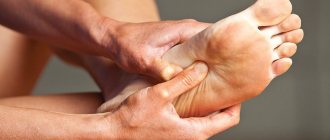Perineal pain in men and women
The content of the article
In the perineal area are the external genitalia, urethra, and anus. Therefore, pain in this area is most often associated with diseases of these particular systems. There can be many reasons for pain.
Clarification of the localization of sensations and a clear definition of the nature of the pain helps to identify the main factor that provoked the pain. Let's consider the main causes of pain in the perineal area.
Causes of acute pain in the perineum
The occurrence of acute, sharp pain in the genital area may indicate the following diseases and conditions:
- Prostatitis.
During an exacerbation of prostatitis, a man experiences intense pain that spreads to the head of the penis and the anus. - Urethritis.
A characteristic feature of pain in urethral inflammation is increased discomfort when emptying the bladder. - Prostate abscess.
The pain is very strong and is one-sided, from the side of the suppuration site. Patients report discomfort in the spine and rectum. The condition is accompanied by difficulty urinating, constipation, hyperthermia (fever) in the area of inflammation. - Prostate cancer.
Acute pain in the perineum is a sign of a late stage of oncology (prostate cancer). - Pinched pudendal nerve.
There are many nerve endings concentrated in the perineum. Pinching of any of them causes acute sharp pain, which subsides when walking and intensifies when sitting or lying down. - Pregnancy, postpartum period.
Pain in this area in pregnant women can be caused by compression of the sciatic nerve (during pregnancy) and be a signal for the onset of labor. Acute postpartum pain occurs in women who have suffered multiple ruptures during childbirth. - Perineal injuries.
Any mechanical damage - bruises, ruptures, tissue cuts, etc. , cause sharp pain.
Treatment
Conservative therapy
The list of therapeutic measures is compiled taking into account the cause of pain in the perineum:
- Inflammatory diseases.
Depending on the type of pathogen, antibacterial, antifungal and antiprotozoal agents of general and local action are used. Women are prescribed sitz baths, douching with herbal decoctions and antiseptic drugs. Sometimes physiotherapy is useful: UV irradiation, UHF, paraffin baths, therapeutic mud. - Vulvodynia.
Sexual abstinence, a calcium oxalate-restricted diet, special exercises, sitz baths, and physical therapy are recommended. For provoking infectious diseases, antimicrobial therapy is carried out; for atrophy, regeneration stimulants are used. For hypoestrogenism, hormones are added to the treatment regimen; for psychoemotional disorders, antidepressants and sedatives are added. - Endometriosis.
The basis of treatment is hormonal drugs, which are selected taking into account the patient’s endocrine profile. Additionally, antispasmodics, analgesics, anti-inflammatory drugs, and immunostimulants are prescribed. - Proctological diseases.
Adjust the diet. Microenemas with anesthetics, herbal decoctions and oil solutions, and rectal suppositories with anti-inflammatory, softening and analgesic effects are used. They use antibiotics, hormones, and phleboprotectors. Non-drug treatment includes sitz baths, perineal showers, diadynamic therapy, laser therapy, and ultrasound. - VRVMT.
Conservative therapy is indicated for grades 1 and 2 of varicose veins, involves taking antiplatelet agents, venotonics and NSAIDs, wearing compression stockings, exercise therapy, and ascending contrast showers. Women are advised to change their physical activity regimen, eliminating stress that worsens the pathology. - CPPS.
The underlying disease is treated. NSAIDs, enzymes, vitamin preparations, antioxidants, and agents to improve blood flow are used. Carry out hormone replacement therapy. Intrapelvic blockades are performed. Patients are referred for physiotherapeutic procedures and acupuncture. To influence the central nervous system, vegetative correctors, sedatives, and psychotherapeutic techniques are used.
Surgery
For pain in the perineal area, the following operations can be performed:
- Endometriosis:
removal of retrocervical lesions, laparoscopic endocoagulation, adnexectomy and hysterectomy with rapid progression of the pathology in older patients. - Proctological diseases:
evacuation of thrombosed hemorrhoids, minimally invasive and classic versions of hemorrhoidectomy, excision of anal fissures, opening of paraproctitis. - VRVT:
embolization, scleroobliteration or endoscopic clipping of ovarian veins, resection of vessels using retroperitoneal or laparotomic access, phlebectomy and miniphlebectomy of the veins of the perineum and vulvar area. - CPPS:
paracervical denervation of the uterus, presacral neurotomy.
Causes of nagging pain
In men, aching, nagging pain in the perineum accompanies chronic prostatitis, urethritis and inflammation of the seminal tubercle (colliculitis). Inflammations with constant nagging pain that worsens during defecation include cooperitis. If a man experiences pain after sexual intercourse and is felt in the testicular area, he needs to be checked for varicocele.
In women, nagging pain is observed during pregnancy and can be caused by chronic pelvic pain syndrome. Stitching and aching pain in the perineum can develop with inflammation of the vaginal mucosa (vaginitis).
6-day immersion course
We began treating our first patients with a variety of pelvic floor dysfunctions at Stanford University in 1995 during routine medical appointments. In 2003, we opened a private practice as a 6-day immersion clinical course in Santa Rosa, California. The course, designed for 14 patients and open for a year, eventually implemented the Wise-Anderson Protocol. This protocol teaches patients how to restore the function of chronically tight pelvic floor muscles and reduce anxiety. The Wise-Anderson Protocol, performed independently at home by patients who have been trained by us, has helped many return to normal life. Following the protocol helps patients eliminate the need to seek additional professional help. For ten years, research has documented our results in teaching patients to self-administer the protocol. For further information, please follow the link to our blades page.
For questions about cost and eligibility please fill out the form below, email us at or contact our office at+1 (707) 332-1492.
SYMPTOMS OF PAIN IN THE PERINEUM
(Most of our patients exhibit two or more symptoms)
Urinary frequency and urge to urinate
- Urinary frequency ranges from annoying to debilitating.
- After urinating, patients feel that the bladder has not been completely emptied and they have the feeling that they need to urinate again.
- Patients have to stay close to the toilet.
- Sometimes patients cannot help themselves when they feel the need to empty their bladder.
- Very often, these symptoms disturb night sleep and lead to lack of sleep, because... patients have to get up frequently at night.
Dysuria (pain or burning when urinating)
- Dysuria (pain or burning when urinating) can be very painful and can make urination an ordeal, leading to further pain.
- Pain or burning when urinating is caused by pelvic floor dysfunction.
- Sometimes people experience pain after, rather than during, urination.
- When the problem with chronic spasms and myofascial tension in the pelvic muscles is resolved, for many patients the pain and burning sensation when urinating also goes away.
Nocturia (frequent urination at night)
- Very often, nocturia (frequent urination at night) leads to nervous exhaustion in patients, because. They don't get enough sleep.
- Chronic fatigue from lack of sleep contributes to a vicious circle: tension, pain, defensiveness and anxiety.
Weakened stream and delayed urination
- It is very important to accurately determine the source of this symptom: whether the weakened flow is caused by an enlarged prostate or something else.
- Some patients with pelvic muscle pain experience delays when starting to urinate.
- Retention may also become worse if the bladder does not empty for longer than usual (tension of the muscles that hold urine leads to a spasm that does not immediately relax when urinating).
- A weakened flow can also affect self-esteem and lead to hypochondria, especially in young people.
- If these symptoms are caused by pelvic muscle pain, then when pelvic floor function is restored, the strength of the jet may improve.
Pain while sitting
- When sitting, patients with pelvic pain suffer even more.
- This symptom complicates all aspects of the patient's life.
- Patients have to sit on something soft.
- Pain in a sitting position brings suffering when the patient is forced to sit for a long time behind the wheel or while flying on an airplane.
- Sometimes patients are forced to register for disability, because... they cannot do sedentary work.
- Discomfort/pain while sitting may be worse and may be felt in the front or back of the pelvis, or both.
- Pain while sitting usually gets worse towards the end of the day, after sitting all day.
Pain in the genitals
- Genital pain is usually referred to the anterior levator ani muscle and is easily relieved in some patients
- Men usually experience pain at the tip or body of the penis
- Redness and irritation are sometimes noticeable at the tip of the penis
PAIN IN THE SUPRAPUBIC AREA
- Pain in the suprapubic region is a common symptom and occurs in patients with urinary problems
- Sometimes pressure in this area can be felt in the anorectal area or cause pain in the bladder.
- The pain is felt on one side or in the middle.
Coccyx pain OR Coccydynia
- Pain in the tailbone is a typical symptom.
- Tailbone pain is usually referred from the pelvic floor or the muscles that attach to the tailbone, but not from the tailbone itself.
- Pain in the tailbone can be caused by pain after bowel movements.
Lower back pain
- Low back pain often confuses patients and doctors because... it is reflected from the pelvic floor muscles and does not originate in the lower back itself.
- Discomfort is experienced on one side, but can also migrate.
Groin pain
- Groin pain is often confused with a hernia.
- The adductors are large, strong inner thigh muscles located in the groin area.
- When these muscles are constantly tense and compressed, they are a source of pain and refer pain to the pelvic region, including the rectum.
Discomfort or the appearance or decrease of discomfort after defecation
- The appearance or reduction of discomfort after defecation occurs when tense pelvic muscles relax.
- Discomfort after bowel movements can be especially bothersome if it worsens symptoms throughout the day.
- This symptom, when it appears in the absence of hemorrhoids or anal fissures, has been little studied, but in our opinion it is typical.
- The mechanism of defecation involves filling the rectum with feces, after which the internal anal sphincter and puborectal muscle are commanded to relax, leading to an urgency to defecate.
- After stool passes through the relaxed anal sphincter, the internal anal sphincter reflexively closes.
- We believe that in patients whose symptoms increase after defecation, the internal anal sphincter closes too tightly, i.e. it contracts more than it was before the bowel movement, and this results in a painful spasm.
- In patients whose muscle tension in the pelvis decreases, pain after bowel movements also decreases.
Symptoms migrate or appear in different places
- Pain may occur in different areas of the pelvis or abdomen.
Decreased libido
- Decreased interest in sex is a typical symptom of pelvic pain.
- We believe that low libido is the result of anxiety, low self-esteem and pelvic pain, which interfere with sexual arousal and interest.
- Getting rid of pain and dysfunction of the pelvic muscles also resolves the problem of low libido.
Anxiety and catastrophic thinking
- The worst thing about pelvic pain is the frightening thought that this pain will never go away.
- This fear occupies all the patient’s thoughts, prevents him from living a full life and paints the future in dark colors.
Depression
- Depression includes feelings of helplessness and the inability to change a situation.
- When doctors are unable to help and the patient does not see light at the end of the tunnel, depression and anxiety tend to appear.
Social isolation and difficulties in intimate relationships
- Social isolation is caused by pain, depriving patients of the opportunity to live a full life.
- Chronic pelvic pain negatively affects relationships, including a partner's refusal to have sex, spend time together, travel, parent, and other daily activities.
Violation of self-esteem
- Self-esteem in patients with pelvic pain decreases, because... they worry that people will avoid them.
Sleep disturbance
- Sleep disturbance is a typical symptom
- Many patients wake up anxious, wondering if the pain has gone away and feeling disappointed if it hasn't.
- Patients wake up due to the need to urinate or because of pain and anxiety
- We published an article about increased morning cortisol levels in patients with pelvic pain. Cortisol and Men with Chronic Prostatitis – Poster presented at the Urological Association meeting, 2007
Helplessness and hopelessness
- Helplessness is caused by the patient's inability to stop the debilitating pain.
- Hopelessness occurs when patients begin to think that nothing can help them.
dyspareunia (pain associated with sexual intercourse)
- Patients experience pain during or after sexual intercourse.
- The pain is felt outside or inside the vagina, or in both places.
- When palpating the pain points, the pain can be reproduced.
CT, MRI and X-ray do not reveal any pathology
- The fact that traditional medical examinations, including blood and urine tests, various scans and other tests, do not find any abnormalities in patients with chronic pain syndrome is frustrating for many patients. Traditional treatment, including antibiotics, alpha blockers, anti-inflammatory drugs, painkillers, surgeries and procedures, does not cure pain.
Increased symptoms or pain with stress
- Normal and increased stress lead to increased symptoms.
- When stress causes pelvic pain, it also triggers a tension-anxiety-pain-defense cycle that continues after the stress has passed.
Pain in the genitals
Soreness of the internal and external genital organs is a symptom that can affect both women and men. In the case of women, the main cause of pain and discomfort in the genitals is diseases of the reproductive system - inflammation of the uterus, fallopian tubes, ovaries and vagina. Another reason is pathology of the clitoris and labia.
As for men, pain in the genital organs (penis, testicles) can be caused by diseases associated with the prostate gland, seminal vesicles and vas deferens. Let's look at the most common causes of discomfort in the genitals for both sexes.
Complications.
Because sexual intercourse is intensely painful, vulvodynia can cause associated emotional problems. For example, fear of sexual intercourse can cause spasm of the vaginal muscles (vaginismus).
Other known complications may include:
- anxiety,
- depression,
- sleep disturbance,
- sexual dysfunction,
- individual psychological problems and difficulties in relationships with a partner,
- decreased quality of life.
Causes of pain in the genital organs in women
Pain in the genital organs in women can occur with the following diseases and conditions:
- Menstruation .
Nagging and aching pain of varying intensity in the lower abdomen and in the genital area may not have a dangerous pathological basis, but may be a sign of menstrual syndrome. - Inflammatory diseases of the female genital organs.
Acute intense pain in this area, spreading throughout the entire lower abdomen, is characterized by inflammation of the uterus and appendages (endometritis and adnexitis). Patients especially complain about the localization of pain in the suprapubic area. An important sign is that the pain tends to gradually intensify. Pain usually develops during the menstrual or postmenstrual period, and also often occurs in women after childbirth. Often accompanied by an increase in body temperature. - Ectopic pregnancy, fallopian tube damage.
The pain in this case develops sharply and is particularly intense, characterized as acute. The condition is very dangerous and requires immediate medical intervention. - Ovarian tumors and twisting of the cyst stalk.
Pain of a tumor nature can manifest itself for a long time as a nagging pain and radiate to the genital area. In later stages, the pain usually intensifies. - Endometriosis.
Pathological growth of the mucous membrane lining the uterus is also accompanied by pain in the vaginal area and external genitalia. - Injuries.
Mechanical damage to the genitals is accompanied by severe pain. - Bartholinitis.
The disease is infectious in nature and causes pain in the external genitalia, which intensifies when walking.
Causes of pain in the genital organs in men
Representatives of the stronger sex often encounter pain syndrome of genital localization, which can be caused by various factors - from excessive stress to tumor processes. The most common causes of pain in the male genital organs:
- testicular torsion;
- epididymitis, which is a consequence of infectious and inflammatory processes;
- malignant and benign testicular neoplasms;
- inguinal hernia;
- varicocele - a condition associated with the expansion of venous structures;
- spermatocele is a disease of a cystic nature;
- Peyronie's disease, accompanied by curvature of the penis;
- inflammatory processes such as balanitis and balanoposthitis, etc.
Preparing for a visit to the doctor.
Most likely, you will start by contacting your primary care gynecologist.
Before your visit:
- write down your symptoms (including those that may seem unrelated to vulvodynia), their intensity and when they started;
- Take a medical history, including other illnesses for which you may be being treated;
- write down all medications, vitamins, or other supplements you take, including dosage.
Make a list of questions for your doctor:
- What could be causing my symptoms?
- What tests do you recommend?
- What treatments are most likely to improve my condition?
- Is this condition permanent or temporary?
- When can you expect relief from discomfort?
- I have other diseases, what should I do?
- Are there any printed materials on this disease? What sites do you recommend?
Feel free to ask other questions.
Your doctor will likely ask you the following questions:
- How severe is your pain and how long does it last?
- How would you describe your pain: sharp or dull, continuous or paroxysmal?
- Is your pain more likely to be triggered by a specific event, such as sexual intercourse or exercise?
- Do you feel pain during urination or bowel movements?
- Does your menstrual cycle affect your pain?
- What can increase or decrease the sensation of pain?
- Have you had surgery on the pelvic organs?
- Have you been pregnant or maybe you are pregnant now?
- Have you been treated for a urinary tract or vaginal infection?
To solve problems associated with vulvodynia, you can make an appointment with a gynecologist at our clinic by calling:
Examination for pain in the perineum and genital organs in men and women
Treatment of any pathologies in the organs of the genitourinary system is carried out by highly specialized doctors: for men - a urologist, for women - a gynecologist. When visiting a doctor, you will need to undergo an examination, tests and ultrasound. According to a short examination program, it is enough to undergo a pelvic ultrasound, take a smear for infections and urine.
If the cause is not found, further research will be required. The doctor may prescribe:
- Ultrasound of the uterus - for women;
- Ultrasound of the scrotum and testicles - for men;
- Ultrasound of the bladder;
- Blood test for biochemistry and other tests.
A timely visit to the specialists of the Diana Medical Center will provide an opportunity not only to get rid of pain in the perineum and genitals, but will also eliminate the root cause of the development of such an unpleasant symptom.
Diagnostics
Establishing the etiology of pain is the responsibility of gynecologists. During the survey, the specialist finds out the circumstances of the appearance of the symptom, the dynamics of its development over time, the connection with various factors (posture, sexual intercourse, natural functions, phase of the menstrual cycle), and the presence of other manifestations. As part of a diagnostic search, procedures such as:
- Gynecological examination.
The doctor evaluates the condition of the perineum, vulva and anus, identifying signs of inflammation and traumatic injuries. Examines the vagina and internal genitalia using one- and two-handed techniques. Girls undergo a rectal-abdominal or rectal examination. - Proctological examination.
Indicated for suspected pathologies of the rectum and anus. Allows you to detect anal fissures, thrombosed hemorrhoids, and signs of paraproctitis. When performing a digital examination of patients with proctalgia, muscle spasms are sometimes detected. - Ultrasonography.
Women are prescribed an ultrasound of the pelvic organs to detect inflammatory processes, cysts, tumors, signs of varicose veins, and determine the causes of pelvic pain. According to indications, ultrasound of the rectum, sonography for paraproctitis, or examination of the genitourinary system are performed. For perineal hernias, an ultrasound scan of the hernial protrusion is performed. - Endoscopic methods.
They are used to determine the causes of the development of CPPS. Depending on the clinical picture and data from other studies, hysteroscopy, sigmoidoscopy, cystoscopy, urethroscopy, colonoscopy, etc. are performed. In some cases, diagnostic laparoscopy is indicated. - Lab tests.
Microscopy of smears and bacterial culture of the discharge are carried out to assess the microflora and determine the causative agent of the inflammatory process. If an STI is suspected, RIF, ELISA, and PCR are indicated. Based on the results of the OAC, the severity of inflammation is assessed and the severity of blood loss in injuries is determined.
In addition, X-ray techniques, computed tomography and magnetic resonance imaging can be used to clarify the diagnosis. If there are indications, a proctologist, urologist, orthopedic traumatologist and other specialists are involved in the examination.
Perhaps explicit images of genitals are hidden here
Are you over 18 years old?
Yes
No
Suturing the perineal rupture


